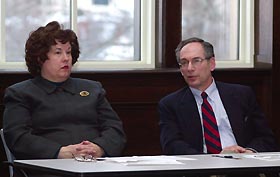|
This is an archived article.
For the latest news, go to the Advance
Homepage
For more archives, go to the Advance Archive/Search Page. |
||
|
Academic Plan Discussed At Public
Forum
By Elizabeth Omara-Otunnu The merits of basic research; class size; and resource allocation strategies were among the issues on the minds of faculty and staff during a discussion February 19 of the first draft pages of a new Academic Plan that will help shape the future of the University.
Seven members of the Academic Plan Task Force fielded questions and comments from an audience of about 40 faculty and staff during the public forum, which was held in the North Reading Room of the Wilbur Cross Building. The task force was established by the Chancellor last fall to assist the administration in making strategic decisions and focusing resources, with a further charge to improve the coordination of 21st Century UConn with the University's academic programs. The 21st Century UConn program, a continuation of the infrastructure renewal begun through UConn 2000, will begin in 2005. The discussion centered on four documents: Areas of Emphasis; Resource Allocation and the Chancellor's Competition; Operating Principles for the Sub-Committee on Facilities and Physical Plan; and 21st Century UConn Prioritization Recommendations. All are available on the web. Richard Brown, director of the Humanities Institute and co-chair of the task force, said draft documents on faculty excellence, student excellence, and implementation are still in preparation. Three members of the Physics Department expressed concerns about what they saw as an overemphasis on external funding, and a focus on applied science at the expense of basic research. Quentin Kessel, a professor of physics, said that "a university is unique in its obligation to carry on long-term research as opposed to short-term research." He said that without this long-term emphasis in the past, many of the amenities enjoyed today - such as lasers - would not have been invented. Barrett Wells, an assistant professor of physics, said technology is an unreliable guide for planning. "You can't predict what technology will come in the future," he said. "There is reason for science on its own merits. A basic understanding of the world we live in is a worthwhile endeavor in and of itself." Winthrop Smith, a professor of physics, said the plan under-emphasizes the educational value of basic science to students. "They have to be taught to be critical," he said. "They need to know enough basic sciences to distinguish the charlatans from the good stuff." Smith added that the drive for external funding described in the plan need not result in a de-emphasis on basic research. "The funding available in a broad range of basic sciences is larger than you might suppose," he said. Brown said the task force would try to address the issue of basic science in more depth. In a discussion of the Areas of Emphasis document, which identifies six broad areas of concentration to encourage the University's constituent units to focus their efforts and to foster multidisciplinar y collaborations, several faculty questioned the appropriateness of the six proposed categories. Some suggested that a more traditional classification might be more workable. The categories now are: arts, culture, and society from a local to global perspective; environmental sustainability; health and human service systems; life sciences; technology innovations and applications; and undergraduate enrichment. Veronica Makowsky, associate dean of liberal sciences and a member of the task force, commented that the intent was to emphasize broad categories and interdisciplinary study. She said using a traditional taxonomy would make UConn "just like every other university." If the intent is to identify areas of emphasis, she continued, then choices must be made. Brown explained that the task force sought to create categories "that would permit a wide array of faculty and programs to find a home within one or more of the categories." He said the areas of emphasis must accommodate the existing physical plant and people at the University. Albert Fairbanks, an associate professor of English, said that in the past few years class sizes have been increasing, yet many of the issues identified as significant in the plan - such as globalization, multicultural perspectives, and human rights - don't lend themselves well to lectures. "There must be opportunities for discussion in class," he said. He said there may be greater pressure to teach large classes as more large classrooms become available, and requested that this situation be addressed in the plan. Karla Fox, associate vice chancellor and co-chair of the task force, said the group would recommend drawing up a classroom plan and monitoring class size. A proposal to distribute some academic resources through a new approach termed "the Chancellor's Competition" was also discussed. The competition would be funded by holding back up to one percent of the academic operating budget. The grants would be in the $50,000 to $500,000 range, to be spent over two years or more. Brown explained that the process of allocating resources through the Chancellor's Competition, a biennial competition, would involve significant assessment by external scholars. Bill Kraemer, a professor of kinesiology and a task force member, said the program is intended to boost UConn's ability to compete with some of "the major players" in the research field. It is not intended to supplant the activities of the Research Foundation. The task force hopes to have a complete draft of the plan available for discussion by the beginning of May, and an interim draft to present to the Board of Trustees in the summer. The plan is expected to be finalized in the fall. |

